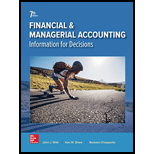
Concept explainers
Inventory: Inventory refers to the stock or goods which will be sold in the near future and thus is an asset for the company. It comprises of the raw materials which are yet to be processed, the stock which is still going through the process of production and it also includes completed products that are ready for sale. Thus inventory is the biggest and the important source of income and profit for the business.
Periodic inventory system: In periodic inventory system the changes in the stock items are reported periodically unlike recording as and when purchases or sales take place.
Cost of goods sold: Cost of goods sold is the total expenses or the cost incurred by the business during the process of manufacturing of goods and is directly related to the production. It generally includes the cost of raw material, labor and other
Gross profit: The profit earned by the company after charging or debiting the cost and the expenses during the production of the goods and to make them ready for sale from the sales made in a fiscal year is the gross profit.
First in first out: In case of First in, first out method, also known as FIFO method, the inventory which was bought first will also be the first one to be taken out.
Last in first out: In case of Last in, First out, also known as LIFO method, the inventory which was bought in the last will be taken out first.
The cost of the ending inventory and the cost of goods sold using:
(a) FIFO
(b) LIFO
(c) Gross margin for FIFO and LIFO method.
Given info,
The cost of goods available for sale is $18,750
(a)
First in, first out method (FIFO)
Cost of ending inventory
| Particulars | Amount($) |
| Most recent cost; October 26: | |
| 100 units @ $25 per unit | 2,500 |
| Next most recent cost; July 30: | |
| 120 units @ $20 per unit | 2,400 |
| Total cost of the ending inventory | 4,900 |
Cost of goods sold
Formula to calculate cost of goods sold is,

Substitute $18,750 for cost of goods available for sale (given) and $4,900 for cost of ending inventory (as calculated above) in the above formula.

Want to see the full answer?
Check out a sample textbook solution
Chapter 5 Solutions
Financial and Managerial Accounting

 AccountingAccountingISBN:9781337272094Author:WARREN, Carl S., Reeve, James M., Duchac, Jonathan E.Publisher:Cengage Learning,
AccountingAccountingISBN:9781337272094Author:WARREN, Carl S., Reeve, James M., Duchac, Jonathan E.Publisher:Cengage Learning, Accounting Information SystemsAccountingISBN:9781337619202Author:Hall, James A.Publisher:Cengage Learning,
Accounting Information SystemsAccountingISBN:9781337619202Author:Hall, James A.Publisher:Cengage Learning, Horngren's Cost Accounting: A Managerial Emphasis...AccountingISBN:9780134475585Author:Srikant M. Datar, Madhav V. RajanPublisher:PEARSON
Horngren's Cost Accounting: A Managerial Emphasis...AccountingISBN:9780134475585Author:Srikant M. Datar, Madhav V. RajanPublisher:PEARSON Intermediate AccountingAccountingISBN:9781259722660Author:J. David Spiceland, Mark W. Nelson, Wayne M ThomasPublisher:McGraw-Hill Education
Intermediate AccountingAccountingISBN:9781259722660Author:J. David Spiceland, Mark W. Nelson, Wayne M ThomasPublisher:McGraw-Hill Education Financial and Managerial AccountingAccountingISBN:9781259726705Author:John J Wild, Ken W. Shaw, Barbara Chiappetta Fundamental Accounting PrinciplesPublisher:McGraw-Hill Education
Financial and Managerial AccountingAccountingISBN:9781259726705Author:John J Wild, Ken W. Shaw, Barbara Chiappetta Fundamental Accounting PrinciplesPublisher:McGraw-Hill Education





